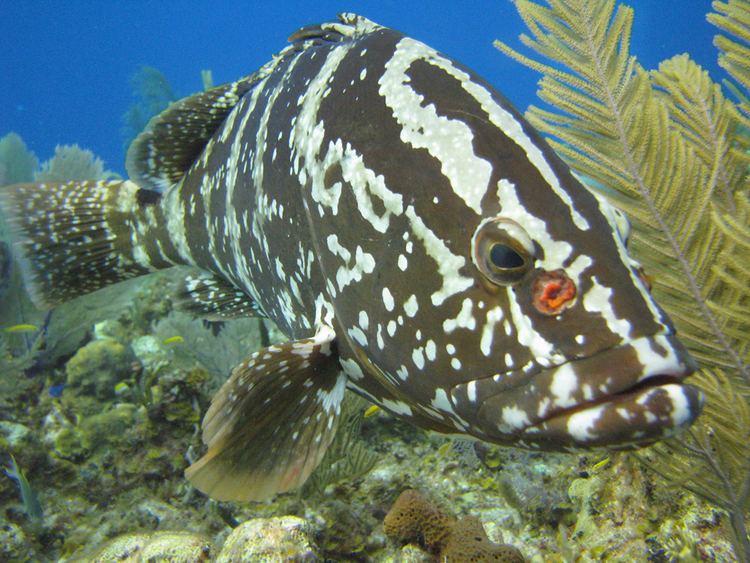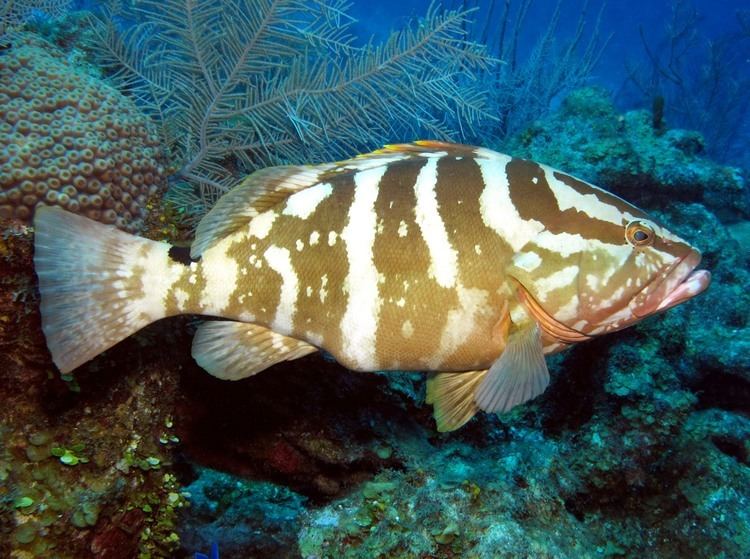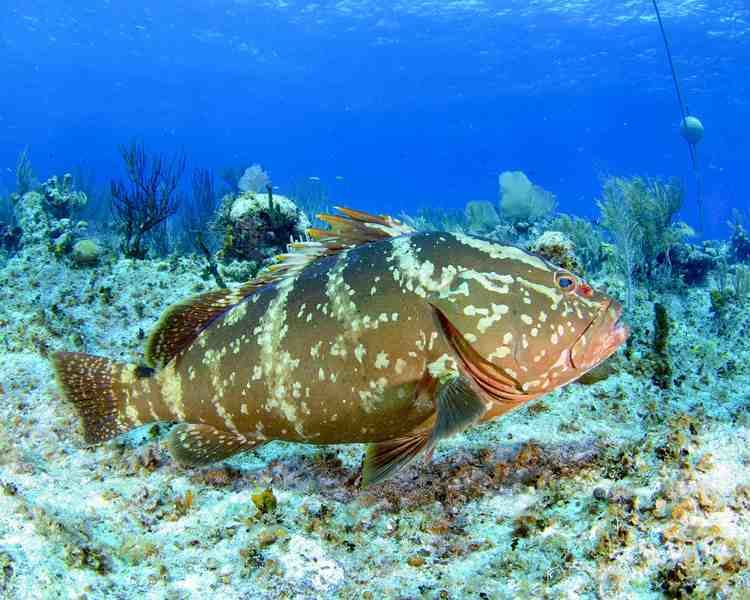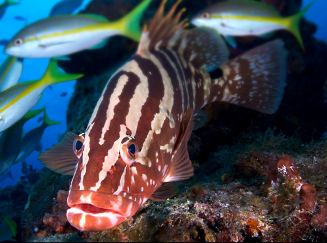Rank Species | Phylum Chordata Scientific name Epinephelus striatus Higher classification Epinephelus | |
 | ||
Similar Grouper, Red hind, Black grouper, Yellowfin grouper, Epinephelus | ||
Caribbean reef fish identification nassau grouper identification
The Nassau grouper (Epinephelus striatus) is one of the large number of perciform fishes in the family Serranidae commonly referred to as groupers. It is the most important of the groupers for commercial fishery in the West Indies, but has been endangered by overfishing.
Contents
- Caribbean reef fish identification nassau grouper identification
- Big nassau grouper shot in bahamas
- Description
- Distribution and habitat
- Biology
- Conservation
- Status reviews
- Further information
- References

The Nassau grouper is a US National Marine Fisheries Service Species of Concern. Species of Concern are those species about which the National Oceanic and Atmospheric Administration and National Marine Fisheries Service have some concerns regarding status and threats, but for which insufficient information is available to indicate a need to list the species under the Endangered Species Act.

Big nassau grouper shot in bahamas
Description

The Nassau grouper is a medium to large fish, growing to over a meter in length and up to 25 kg in weight. It has a thick body and large mouth, which it uses to "inhale" prey. Its color varies depending on an individual fish's circumstances and environment. In shallow water (up to 60 ft), the grouper is a tawny color, but specimens living in deeper waters are pinkish or red, or sometimes orange-red in color. Superimposed on this base color are a number of lighter stripes, darker spots, bars and patterns, including black spots below and behind the eye, and a forked stripe on the top of the head.
Distribution and habitat

The Nassau grouper lives in the sea near reefs; it is one of the largest fish to be found around coral reefs. It can be found from the shoreline to nearly 100-m-deep water. It lives in the western Atlantic Ocean, from Bermuda, Florida, and the Bahamas in the north to southern Brazil, but it is only found in a few places in the Gulf of Mexico, most notably along the coast of Belize.
Biology
It is a solitary fish, feeding in the daytime, mainly on other fish and small crustaceans such as crabs and small lobsters. It spawns in December and January, always around the time of the full moon, and always in the same locations. By the light of the full moon, huge numbers of the grouper cluster together to mate in mass spawning.
Conservation
The Nassau grouper is fished both commercially and for sport; it is less shy than other groupers, and is readily approached by scuba divers. However, its numbers have been sharply reduced by overfishing in recent years, and it is a slow breeder. Furthermore, its historic spawning areas are easily targeted for fishing, which tends to remove the reproductively active members of the group. The species is therefore highly vulnerable to overexploitation, and is recognised as endangered on the IUCN Red List. The governments of the United States, the Cayman Islands, and the Bahamas have banned or instituted closed fishing seasons for the Nassau grouper in recent years. In the Cayman Islands, fishing in the spawning holes of the grouper has been banned until the end of 2016. In the case of the Bahamas, the government has instituted a closed fishing season in which fishing for the Nassau grouper is banned from December to February. It is in a very high rate decline and is at serious risk of becoming extinct.
A large spawning site for the species is located at Glover's Reef, off the Belizean coast. It has been identified as one of only two viable sites remaining for the species, of 9 originally known locations. In 2002, a permanent marine protected area was established on Glover's Reef. However, the Nassau grouper's spawning region is not included in this marine protected area (MPA). Instead, their spawning area (located north of the MPA) is subjected to a three-month closure during winter spawning aggregations.
Many conservation methods have been put in place to help the grouper, including closed seasons, when fishing is not allowed. These seasons take place during the spawning season. Regulations allow only fish over 3 lb to be harvested to give the younger fish a chance to spawn. Some areas are protected, a complete ban on fishing the grouper in US waters has been instituted. Also, protection of the spawning sites at all times is in effect in certain places.
Status reviews
The U.S. National Marine Fisheries Service recently completed a review of the status of the species for Endangered Species listing. They proposed to list the species as endangered.
The Nassau grouper has been depicted on postage stamps of Cuba (1965, 1975), the Bahamas (1971 5-cent), and Antigua and Barbuda (1987 40-c).
The threats to the grouper include overfishing, fishing during the breeding period, habitat loss, pollution, invasive species, and catching undersized grouper.
The Nassau grouper was placed on the World Conservation Union’s redlist of threatened species in 1996, and it was determined to be endangered because its population has declined by 60% in the past 30 years. Over a third of spawning aggregations have been estimated to have disappeared, and the grouper is considered to be commercially extinct in some areas.
The current population is estimated to be more than 10,000 mature individuals, but is thought to be decreasing. Their suitable habitat is declining; they need quality coral reef habitats to survive. Their population outlook is not optimistic.
